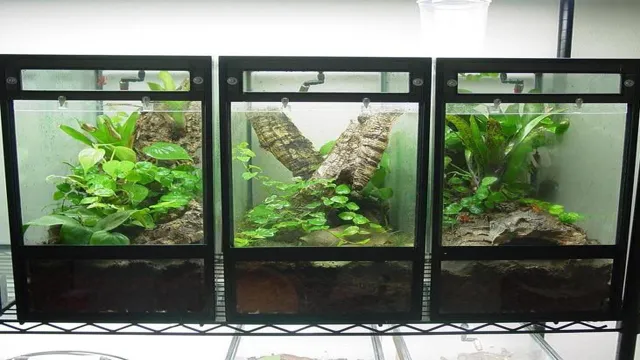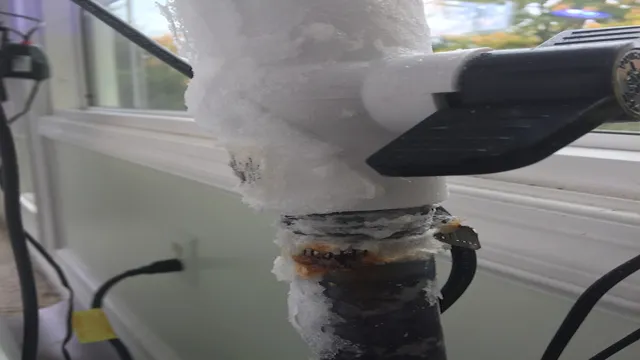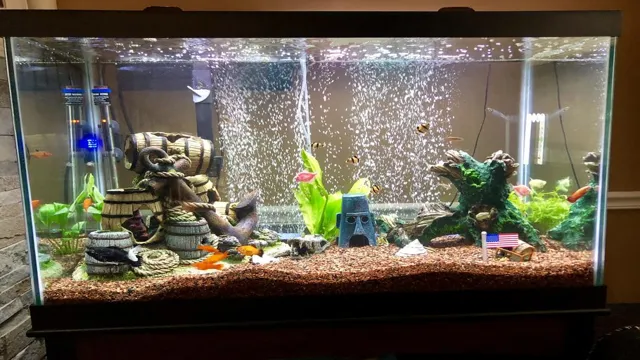How to Convert an Aquarium Tank to Horizontal: Tips and Tricks for a Seamless Transformation

Have you been thinking about changing up your aquarium setup? Maybe you want a new look, or you’d like to give your fish a more spacious home. Whatever your reason may be, one option you may not have considered is converting your aquarium tank to a horizontal style. This can provide many benefits, such as giving your fish more room to swim and allowing for a wider variety of aquatic plants to be added.
In this blog post, we’ll explore the steps involved in converting an aquarium tank to a horizontal style, as well as the factors to consider before making the switch. So, let’s dive in and discover the potential of transforming your aquarium tank into a horizontal wonderland!
Assess Tank Size And Type
If you’re considering converting an aquarium tank to horizontal, one of the first things you’ll need to do is assess the tank size and type. While most aquariums can be converted, it’s important to choose a tank that’s the right size for the fish you want to keep. A smaller tank may work for some species, but others may require a larger space to thrive.
You’ll also need to consider the type of aquarium you want to create. Will it be a freshwater or saltwater tank? Are you looking to create a tropical or temperate environment? Each type of tank will require different equipment and care, so it’s important to research and plan ahead before making any changes. By assessing the tank size and type, you’ll be able to create a comfortable and healthy environment for your fish.
Determine if Tank Is Suitable for Conversion
Before embarking on a conversion project, it’s important to assess whether the tank is suitable for conversion. The first step is determining whether the size and type of the tank meet your requirements. For instance, if you’re using the tank for residential purposes, a smaller size would suffice.
However, if you’re planning to use it for commercial purposes, a larger tank would be ideal. Similarly, the type of tank matters as well, as there are different types such as propane, oil, and water tanks. You need to determine which type of tank you have and whether it is suitable for conversion to your intended use.
Assessing the tank size and type early on in the conversion process can help you make a more informed decision on whether the tank is worth the effort and investment required in the conversion process.

Check the Tank’s Material
When choosing a water tank, it is important to not only consider the size and type but also the material it is made of. Different materials have varying levels of durability, corrosion resistance, and cost. The most common materials for water tanks are plastic, concrete, and steel.
Plastic tanks are lightweight and easy to install, while concrete tanks provide excellent durability and low maintenance. Steel tanks are also quite durable, but they can be prone to rusting and require regular maintenance to prevent corrosion. Ultimately, the choice of material will depend on your specific needs and budget.
Don’t forget to also consider the environmental impact of your choice and opt for a tank made from eco-friendly materials if possible. By assessing the tank size and type alongside the material, you’ll be able to make an informed decision that meets your water storage needs.
Buy Necessary Equipment
If you’re looking to convert an aquarium tank to horizontal, there are a few things you’ll need to purchase to get started. Obviously, you’ll need a tank that’s suitable for your needs; this might mean finding one that’s already built for horizontal use, or making modifications to a vertical tank. You’ll also want to invest in a filter and heating system that will work well with the new orientation of your tank.
Additionally, you’ll need to consider the lighting and substrate you’ll be using, as these can have an impact on the health of your aquatic pets. Once you have all the necessary equipment, you’ll be ready to start the process of transitioning your tank from vertical to horizontal. With some patience and careful planning, you’ll soon be enjoying the benefits of a new and improved aquarium setup.
Purchase Acrylic or Glass Sheet
If you’re interested in creating beautiful, unique displays or artwork, investing in a sheet of acrylic or glass can make all the difference. When it comes to choosing between acrylic and glass, there are a few things to keep in mind. Acrylic is lighter and more durable than glass, so it is a great option for projects that require some flexibility or could be bumped or knocked over.
Glass, on the other hand, is more scratch-resistant and has a more traditional look and feel. Once you have decided which material to use, you will need to find a supplier. Many home improvement stores carry acrylic or glass sheets, but you can also find them online.
When purchasing your sheet, remember to measure the space where it will be placed or cut to a specific size beforehand. It’s always better to buy a larger sheet, as you can always trim it down to the size you need. With your new sheet in hand, you’ll be able to create amazing artwork or displays that will be the envy of all your friends.
Acquire High-Quality Silicone Caulk
When it comes to sealing gaps or cracks in your home, choosing the right caulk can make a world of difference. Silicone caulk is an excellent choice for its durability, waterproof properties, and flexibility, making it perfect for use in areas that are exposed to moisture, such as bathrooms and kitchens. Before you get started, be sure to purchase the necessary equipment, including a caulk gun and a scraper.
As for silicone caulk, don’t skimp on quality. Choosing a high-quality product will ensure that your sealant is long-lasting and effective. Cheaper options may not adhere well to the surface, and could even degrade over time.
Look for a product that specifies it’s appropriate for indoor use and is resistant to mold and mildew. A little extra investment in the right tools and materials now can save you a lot of money and frustration in the long run.
Drain and Remove Fish
If you’re looking to convert your aquarium tank from vertical to horizontal, there are a few steps you need to take. First, drain the tank and remove any fish or other aquatic creatures that might be living in it. Once you’ve done that, you can start to think about how you want to arrange the tank in its new orientation.
One option is to simply lay it down on its side, but you may also want to add some additional supports or braces to ensure that it stays in place. Additionally, you’ll need to think about how to arrange any plants, rocks, or other decorations that may have been in the tank before. In order to ensure that everything stays in place and looks natural, you might want to experiment with different placement options before settling on a final configuration.
With a little bit of planning and some careful execution, you can successfully convert your aquarium tank to a horizontal orientation and create a visually stunning underwater environment for your aquatic friends to call home.
Carefully Remove Water from the Tank
When it comes to cleaning your fish tank, an essential step is to drain and remove the fish before proceeding. This might seem like common sense, but it’s crucial for the well-being of your aquatic pets. Start by unplugging any electrical equipment and carefully transferring your fish to a temporary tank or container filled with water from the original tank.
Once the fish are safely relocated, you can start draining the water. Use a siphon or aquarium vacuum to remove the water, being careful not to disturb the gravel or decorations at the bottom of the tank. This will help remove any debris or waste that might have accumulated.
Once the tank is empty, use a damp cloth or sponge to wipe down the sides and bottom of the tank. Finally, let the tank air out for a few hours before refilling it with fresh water and returning your fish to their home. By carefully removing the water and taking the time to clean the tank thoroughly, you can help ensure a healthy environment for your aquatic pets.
Remove Any Objects and Fish from the Tank
Before starting with any aquarium maintenance, it’s essential to remove any objects or fish present in the tank. First, turn off all the electronic equipment such as filters and heaters for safety reasons. Carefully capture the fish with a net and transfer them to a temporary container with enough water to keep them alive.
It’s essential to keep the water temperature and oxygen levels stable in this container. Next, remove any rocks, plants, or decorations from the tank. If there are stubborn algae or debris attached to these objects, scrub them off gently with an aquarium brush.
Once everything is removed, drain the water out of the tank, and dispose of it appropriately. It’s worth noting that before removing the fish, it’s essential to have a definite plan for where they will go and when they will be put back into the tank. It’s not recommended to keep them out of the water for an extended period to prevent harm or damage.
As you begin this process, also remember to clean your hands before and after handling anything in the tank to maintain good hygiene and avoid contamination. By following these steps, you’ll create a safe environment for your fish and be on your way to a clean, healthy tank.
Cut and Install Sheet
Converting an aquarium from vertical to horizontal can be a challenging project, but with the right steps, it can be accomplished successfully. One of the key steps is cutting and installing the sheet that will serve as the base of the new horizontal tank. To start, you’ll need to measure the dimensions of the tank and purchase a tempered glass sheet that will fit those measurements.
Once you have the sheet, carefully use a glass cutter to cut it to the correct size. Then, clean the edges of the glass to remove any sharp or jagged areas. Finally, install the sheet into the tank by applying silicone sealant along the edges and carefully positioning it in place.
Allow the silicone to dry completely before moving on to the next step. Overall, with patience and attention to detail, cutting and installing the sheet to convert your aquarium can be a successful DIY project.
Measure and Mark Sheet According to Tank Size
When it comes to installing a tank, proper preparation is key. One important step is to measure and mark the sheets according to the tank size. Start by taking accurate measurements of the tank’s diameter and height.
Remember to factor in any additional measurements for the tank’s fittings and supports. Once you have your measurements, mark them on the sheets with a pencil or marker. Next, it’s time to cut the sheets to size.
Use a cutting tool that is appropriate for the type of sheet you are using, whether it be metal, plastic, or composite materials. As you make your cuts, ensure that they are precise and accurate to avoid any gaps or leaks when installing the sheets onto your tank. Once the sheets are cut, carefully install them onto the tank, making sure each sheet aligns with the measurement marks you made earlier.
With proper preparation, cutting, and installation, your tank will be ready for use in no time!
Use Glass Cutter or Jigsaw to Cut Sheet
When it comes to cutting sheets for DIY projects, there are a few options available. One of the most common methods is to use a glass cutter or jigsaw to make precise cuts. A glass cutter works well for thinner sheets, while a jigsaw is better for thicker materials.
To use a glass cutter, simply score the sheet with a straight edge and then apply pressure to break it along the scored line. For a jigsaw, use a fine-toothed blade and make slow, steady cuts while keeping the sheet firmly in place. Once the sheet is cut to size, it’s important to install it properly to ensure a secure fit.
This may involve using adhesives, screws, or other fasteners to hold the sheet in place. With a little bit of practice and some basic tools, you can easily cut and install sheets for all kinds of DIY projects.
Apply Silicone Caulk and Install Sheet
To properly cut and install a sheet, you will first need to measure the area to ensure the sheet fits snugly. Once you have your measurements, take a utility knife and score the sheet along the line where it needs to be cut. Be sure to use a straight edge to guide your knife for a clean cut.
After you have cut the sheet, clean the area where it will be installed and apply a silicone caulk along the edges of the surface. This will help to prevent moisture from seeping into the area and damaging the sheet. When installing the sheet, be sure to align it properly with the edges of the surface and press it firmly in place.
Smooth out any air bubbles or wrinkles to ensure a clean, smooth finish. With these simple steps, you can effectively cut and install a sheet to add both functionality and aesthetic appeal to your space.
Let Silicone Caulk Dry
If you’re considering converting your aquarium tank to a horizontal setup, there are a few things you’ll need to keep in mind to ensure that the transformation goes smoothly. The first step is to let the silicone caulk dry completely. This may seem like a small detail, but it’s crucial to the success of your project.
The caulk is what holds the tank together, and if it hasn’t fully cured, you could end up with leaks or even a collapsed tank. Make sure that you follow the manufacturer’s instructions for drying time, and avoid rushing the process. Once the caulk has dried, you can begin the process of flipping your tank over and securing it in its new horizontal position.
This may involve making modifications to your filtration system, lighting, and other equipment, so be prepared to invest some time and effort into the project. With a little patience and some careful planning, you’ll be able to create a stunning horizontal aquarium that will be the envy of your friends and family.
Allow for Sufficient Drying Time
When it comes to using silicone caulk, allowing for sufficient drying time is crucial. Many people make the mistake of assuming that the caulk is dry once it has been applied. However, this is not the case.
In order for the caulk to form a proper seal, it needs to be given enough time to fully dry and cure. The exact amount of time required will depend on a variety of factors, such as the humidity levels and temperature. As a general rule, it is best to wait at least 24 hours before using the area where the caulk has been applied.
This will ensure that the caulk has had enough time to fully set and harden, providing you with a seal that is both durable and long-lasting. By being patient and allowing for sufficient drying time, you can ensure that your silicone caulk project is a complete success.
Check for Any Leaks Once Silicone Has Dried
Once you have applied silicone caulk to a surface, it is important to let it dry completely before checking for any leaks or defects. Although the drying time may vary depending on the temperature and humidity of the environment, it is best to wait at least 24 hours before testing the seal. Rushing the drying process could compromise the integrity of the seal and lead to leaks.
It is also important to note that once the silicone has dried, it may have a slight give to the touch but should not be tacky. If it is still tacky, it needs more time to dry. Before checking for leaks, it is important to inspect the surface that was sealed to ensure that it is free from debris, moisture, or any other potential contaminants that could affect the adhesion of the silicone.
By taking the time to properly apply and dry the silicone, you can ensure a watertight seal that will provide long-lasting protection. Remember, patience is key!
Re-Add Water and Fish
If you’re looking to convert your aquarium tank to a horizontal setup, there are a few steps you’ll need to follow. Firstly, you’ll need to empty the tank completely, removing any fish, plants, and decorations. Next, you’ll need to carefully turn the tank onto its side, making sure to avoid any damage to the glass.
Once the tank is in its new position, you can begin to add in the necessary equipment, such as lighting and filtration systems. Finally, re-add water to the tank, making sure to carefully monitor for any leaks or weaknesses in the new setup. Don’t forget to add in any fish or plants that were previously housed in the aquarium, but make sure to acclimate them to the new environment gradually.
Overall, converting your aquarium tank to a horizontal setup can be a great way to switch things up and maintain a healthy and happy aquatic environment for your fish.
Fill Tank with Water and Add Fish
Once you have filled your tank up with water and set up your filtration system, you can finally add your fish to their new home. It is important to take your time and not rush this process. To ensure the water is safe for your new fish, you should add a water conditioner to remove any harmful chemicals, such as chlorine and heavy metals, that may be in your tap water.
Once you’ve treated the water, you can slowly add the fish to the tank. Don’t add all the fish at once, as this can cause a spike in ammonia and harm your new pets. Instead, add a few fish at a time, allowing the biological filtration to adjust accordingly.
Make sure the temperature of the water is suitable for your fish, as some species require warmer water than others. By following these steps, you can create a healthy and safe environment for your fish to thrive in.
Test Water Quality Before Returning Fish
After conducting water tests and ensuring that the water quality is safe, it’s time to re-add the fish to their tank. Carefully acclimate the fish to the new water temperature by floating their bag in the tank for about 10-15 minutes. Then, slowly add small amounts of the tank water into the bag over a period of 15-20 minutes.
Once the fish are fully acclimated, release them into the tank. It’s important to monitor the fish closely for the first few days after adding them back into the tank to ensure they are healthy and behaving normally. Remember, a sudden change in water conditions can stress out fish and make them vulnerable to disease.
By taking the time to test the water quality and acclimate the fish properly, you can create a healthy environment for your aquatic pets to thrive in!
Maintenance and Upkeep
Converting an aquarium tank from vertical to horizontal is a process that requires a few steps and some careful planning. First, you’ll need to determine the size and shape of the new tank. There are many different types of tanks available, so take some time to research and find one that suits your needs.
You’ll also need to consider the weight of the tank and the space where it will be located. Once you have your new tank in hand, you’ll need to transfer your fish and other aquarium inhabitants over to the new setup. This can be stressful for your fish, so it’s important to take your time and do it carefully.
After the transfer, you may need to adjust your filtration, lighting, and other equipment to accommodate the new tank. With a little bit of planning and care, you can successfully convert your vertical aquarium tank to a horizontal one and provide your aquatic pets with a new and improved environment to thrive in.
Check Tank Frequently for Any Damage or Leaks
Maintaining your tank is crucial, especially if you want to keep your aquatic pets healthy and happy. One of the most important things you should do regularly is checking the tank for damage or leaks. Even a small crack or hole can spell disaster for your finned friends and could lead to a lot of damage to your property.
Not to mention the cost of water bills, which can skyrocket if you’re not careful. Therefore, make sure to check your tank frequently for any damages or leaks that need attention. Close monitoring of your aquarium’s condition may sound like a hassle, but it can be done easily with a few simple steps.
To start, inspect the outer walls of the tank for any visible cracks or signs of damage. Next, examine the bottom and sides of the tank for any leaks that may be invisible to the naked eye. You can do this by wiping a thin layer of tissue or paper towel over these areas and observing if there is any moisture present after a while.
If you notice any damage or leaks, take immediate action by fixing it or replacing the tank entirely. You can use silicone sealants to repair cracks or holes, but make sure to follow the manufacturer’s instructions carefully. Alternatively, if the damage is irreparable, it’s best to replace the tank to avoid any future problems.
In conclusion, keeping your tank in excellent condition is vital to the health and well-being of your aquatic pets. Therefore, make sure to check it frequently for any damages, leaks, or signs of wear and tear. With proper maintenance and upkeep, your tank will be a joy to behold and enjoyable for you and your aquatic pets for years to come.
Clean and Maintain Tank Regularly to Ensure Health of Fish
Keeping your fish tank clean and healthy requires regular maintenance and upkeep. One of the most important tasks is cleaning the tank on a routine basis. When you clean your tank, you remove any debris and waste that may have accumulated, as well as any harmful bacteria that may linger in the water.
Make sure to scrub the tank walls and decorations, replace the filter cartridges, and perform water changes at least once a week. Neglecting to do so can lead to the buildup of toxins, which can harm your fish and other aquatic life. In addition to cleaning the tank, you should also monitor and maintain the appropriate temperature and pH levels to ensure a healthy environment for your fish.
Remember, a healthy and well-maintained tank will prolong the life of your fish and create a beautiful centerpiece for your home. So, keep up with regular maintenance to ensure the health and happiness of your aquatic pets!
Conclusion
In conclusion, converting an aquarium tank from vertical to horizontal requires a bit of creativity, some basic handyman skills, and a willingness to think outside of the box. Whether you’re looking to create a more stunning underwater landscape or simply want to keep larger fish species, a horizontal tank can provide a unique and visually appealing alternative to the traditional vertical aquarium. With a little elbow grease and some careful planning, your fish will be swimming in style in no time.
“
FAQs
Why would someone want to convert an aquarium tank to horizontal?
Converting to a horizontal tank can provide a different viewing experience, as well as offer more space for aquatic plants and animals.
What tools are needed to convert an aquarium tank to horizontal?
Depending on the tank setup, tools may include a saw, drill, sandpaper, and silicone sealant.
Can any aquarium tank be converted to horizontal?
It is possible to convert most aquarium tanks, but it is important to research the specific tank and ensure it is structurally sound for the conversion.
How do you measure and cut an aquarium tank for horizontal conversion?
Measure and mark the desired dimensions on the tank, use a saw to carefully cut along the markings, and sand down the edges to ensure a smooth finish.
What precautions should be taken before and during the conversion process?
Ensure the tank is completely empty and cleaned, wear safety gear such as gloves and safety glasses, and take care when working with tools or equipment.
Can multiple aquarium tanks be connected horizontally?
Yes, it is possible to connect multiple tanks to create a larger, horizontal setup. However, this will require additional planning and equipment.
What are some unique design options for a horizontal aquarium tank?
Options include adding multiple tiers or levels, integrating aquatic plants or rock formations, and creating a more natural environment for the aquatic animals.






